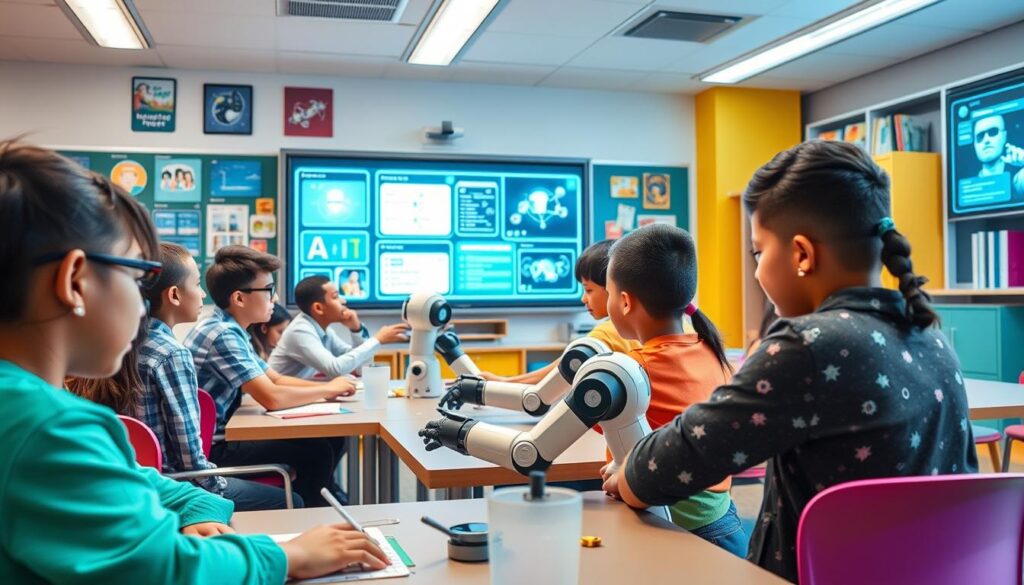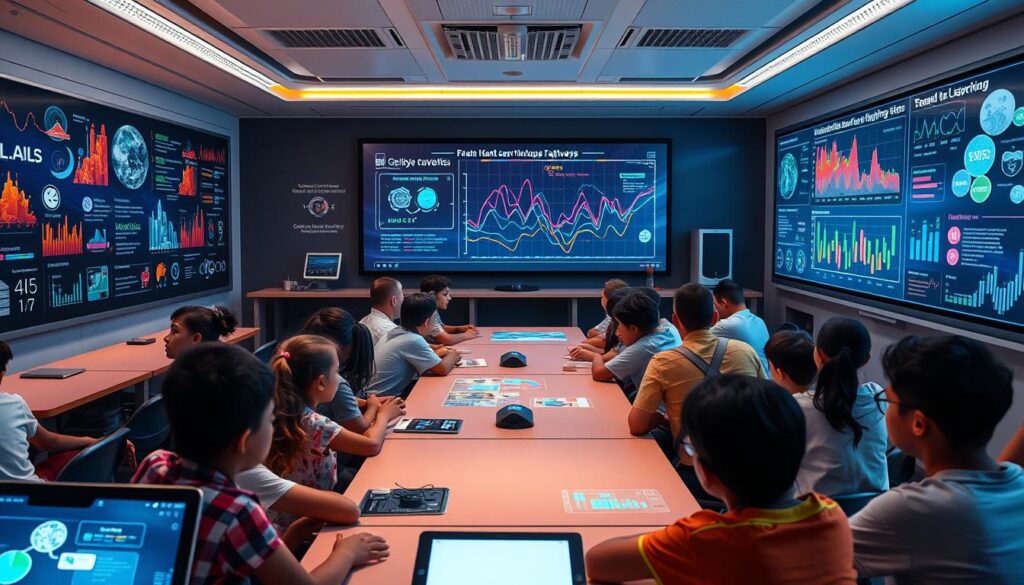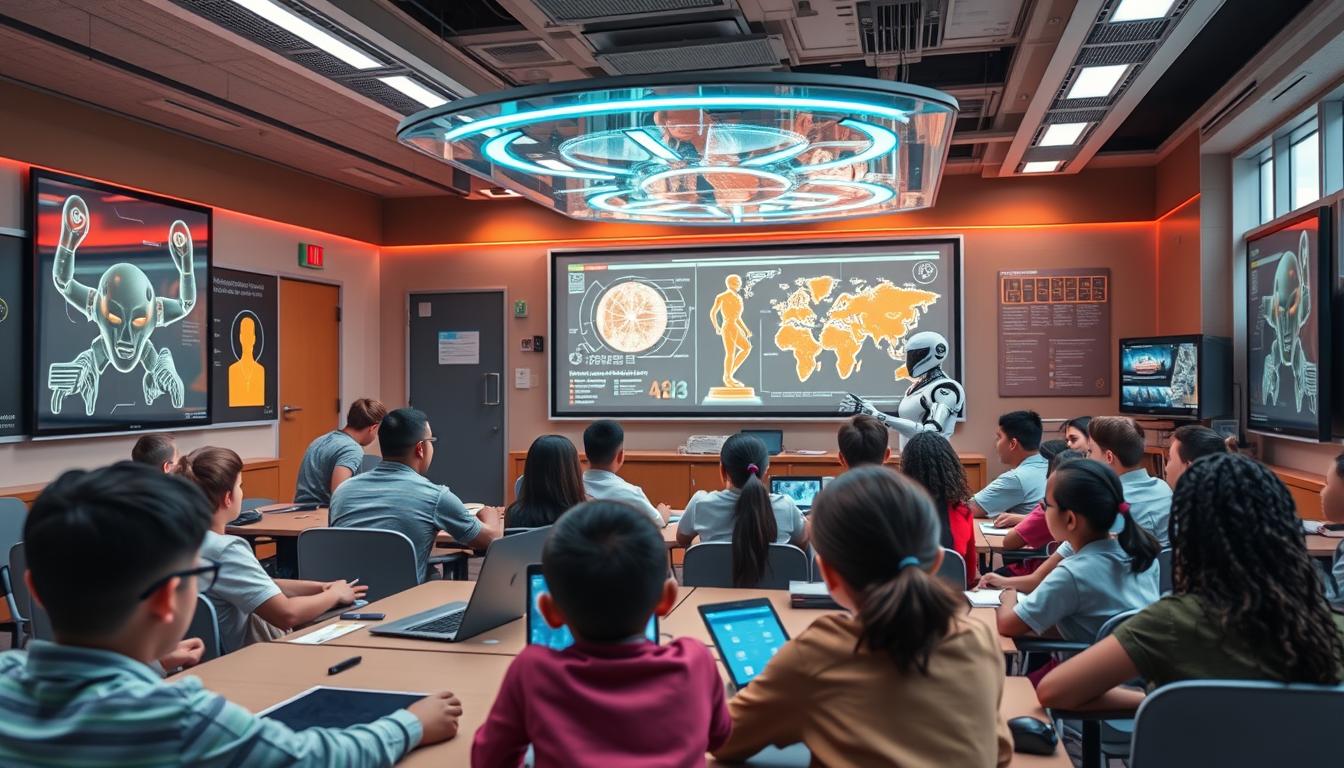The use of artificial intelligence in learning is changing education a lot. It’s a big step towards better ways of learning. As education moves towards Education 4.0, it focuses more on personalization and using educational technology AI in new ways.
Experts say the AI in education market will grow to over $46.4 billion by 2024. This shows how big AI’s role is in schools1. This area helps edtech companies meet different learning needs, making education better for each student. It’s moving from old classroom ways to new ones based on machine learning for students.

Key Takeaways
- 88% of students see AI as important in education.
- AI tools make learning more personal and fun.
- AI can predict who might struggle or drop out.
- There are worries about AI’s ethics and keeping data private.
- The future of education needs to balance new ideas with being responsible.
Introduction to AI in Education
AI in education uses algorithms and machine learning to improve teaching. It helps tailor learning to each student’s needs. This way, schools can offer personalized learning with AI that fits each student’s learning style and pace.
Artificial intelligence has changed many fields for decades. Alan Turing, a British logician, is seen as its founder. The first AI program was made in 1951 to play checkers fast. Now, AI helps with school work, giving quick feedback and fun learning tools. It also helps students learn from anywhere, making education more accessible.
Studies show that AI is making learning better, thanks to the U.S. National Science Foundation. In 2019, the NSF helped set rules for K-12 education to include AI in lessons2. AI projects also teach important skills like social skills and how to use technology, getting students ready for an AI world3.
AI has the power to change education for the better, making learning more fun. But, there are worries about AI’s impact, like biases and privacy issues. This shows the importance of educators and leaders keeping up with AI in education.
AI systems are now capable of surpassing human performance in certain tasks, setting a foundation for groundbreaking advancements in education.
Educational technology AI brings new ways to make learning personal and engaging. It helps tackle the challenges of today’s classrooms. As AI keeps growing, it’s crucial to have resources and training for everyone to use it well4.
The Benefits of Implementing AI in the Classroom
AI in schools brings big wins for both teachers and students. It makes learning personal by adjusting content to fit each student’s needs. This boosts engagement and understanding.
AI also helps teachers track how well students are doing in real-time. This means students get feedback faster and do better by about 30%5. Teachers can then focus more on teaching, making their work up to 40% more efficient5.
AI tools make learning materials more accessible, by up to 50%5. This helps all students, no matter their background or where they live. AI also helps students learn on their own by giving them quick help from virtual assistants.

But, there are downsides to watch out for. Overusing technology can hurt skills like problem-solving by 20%5. Easy access to info might also make students forget things more easily, by up to 45%5.
As AI in schools grows, it has the power to change how we learn. With the right use and training, AI can make classrooms more fun and interactive.
AI in Education: Practical Applications
AI changes education in many ways, helping students learn and teachers teach better. Learning Management Systems (LMS) like Moodle and Blackboard help teachers manage courses. They also make it easy for students and teachers to communicate.
These systems track how well students are doing and make learning better for everyone.
Intelligent Tutoring Systems (ITS) like Carnegie Learning’s MATHia and IBM Watson Tutor use AI to help students. They give personalized lessons based on what each student needs. This makes learning fit each student’s own pace and interests6.
AI also makes education more accessible for everyone. It helps visually impaired students by turning text into speech. It also helps students who speak English as a second language by translating lessons. Plus, it provides real-time captions and transcriptions for a more inclusive classroom7.
AI can find out where students need help and adjust lessons on the fly. This means students get help when they need it most. Teachers can then focus on teaching, not just paperwork6.
In short, AI in education makes learning better, more efficient, and inclusive. It makes every student’s journey unique and valuable8.
How Adaptive Learning Systems are Enhancing Student Outcomes
Adaptive learning systems are changing education by using algorithms for personalized learning. They help students by focusing on their specific needs. This way, students can learn better and faster.
These systems check what students know and adjust their lessons to fit their learning style. This ensures students make progress at their own pace.
Many students use adaptive learning systems today. These tools use advanced technology to spot and fix mistakes quickly. This helps students avoid falling behind in their studies.
DreamBox Learning shows how well adaptive technology works. Students who used it for 60 minutes a week got much better at math.
Adaptive learning systems also give teachers valuable feedback on student performance. This helps teachers tailor their teaching to meet each student’s needs.
It’s important for schools and policymakers to work together. They need to make sure everyone has access to these learning tools. This is crucial as the job market changes and new careers emerge.

AI-powered Classroom Tools Enhancing Teaching
AI classroom tools are changing how we teach, making it better for teachers. Over the last five years, teachers have started using AI more. This has changed how students learn and interact with their materials9.
These tools help teachers be more creative and productive. They also give insights into how students learn. This makes teaching easier and less time-consuming9.
Tools like ChatGPT are making classrooms more interactive. They help with language tasks and can change how we teach. This opens up new ways to improve education10.
AI tools like AudioPen and Canva Magic Write help teachers make lessons fast. They just need to give a prompt. This makes planning and teaching more efficient9.
Tools like Quizizz and Slidesgo offer personalized learning. They make content creation easier for teachers9. Quizizz, for example, adjusts questions based on what students answer. This helps students learn better9.
Talking to students about AI tools is important. It helps keep learning honest and clear10.
AI analytics help tailor learning to each student. This makes education more personal and effective9. Teachers can meet their students’ needs better, leading to better learning10.
Challenges and Ethical Considerations in AI in Education
AI in education brings big changes but also big challenges and ethical questions. A big worry is data privacy. A survey showed 65% of parents are concerned about how AI uses their kids’ data in schools11. Also, the digital gap is still a problem, with 72% of U.S. public schools lacking the tech for AI education11.
AI tutoring systems can have bias too. Research shows they often give different feedback based on who you are. For example, boys might get more help than girls, showing a bias11. Teachers also worry about relying too much on AI, with 78% fearing it could hurt the teacher-student bond11.
AI systems in schools are not always clear about their decisions. Only 30% explain how they make choices11. This lack of transparency makes it hard to hold AI accountable for its decisions. We need to tackle these issues to make sure AI helps learning fairly and effectively.
As AI gets better, we need better rules and standards. About 40% of countries don’t have good rules for AI in schools11. We need laws that make sure AI is fair and everyone has access to it. This is key to creating a learning environment that’s inclusive and ready for the future.
Conclusion
AI in education is changing how we teach and learn. It promises to make learning more engaging and tailored to each student. AI helps students get help anytime and makes sure lessons fit their needs, improving learning outcomes12.
AI also makes learning accessible worldwide, offering equal chances for everyone12. Sites like Khan Academy and Duolingo show how AI is changing education. They offer customized lessons and feedback, making learning more effective13.
As schools deal with AI’s challenges and ethics, it’s clear AI is more than just a tool. It’s driving new, inclusive ways to teach. This shift could make learning more fun and meaningful for everyone1213.
As AI continues to advance, its impact on industries is becoming more profound. For more insights on how AI is shaping the future of business, check out our article on the latest innovations in AI technology.
Source Links
- Council Post: Personalized Learning And AI: Revolutionizing Education
- AI education and AI in education
- AI in Education
- AI In Education: Introduction » Britannica
- The Benefits of AI in Education – CIS University
- Artificial Intelligence in Education
- AI in Education: Enhancing Accessibility for All Students | OrCam
- Learning With AI, Learning About AI
- 7 AI Tools That Help Teachers Work More Efficiently
- AI Tools in Teaching and Learning
- Research Guides: Artificial Intelligence (AI) in Education: AI and ethics
- AI In Education Sector: Benefits, Use Cases, The Future | Yellow
- AI in Education: The End of Schools As We Know Them?


1 thought on “AI in Education: Revolutionizing Learning”
Comments are closed.